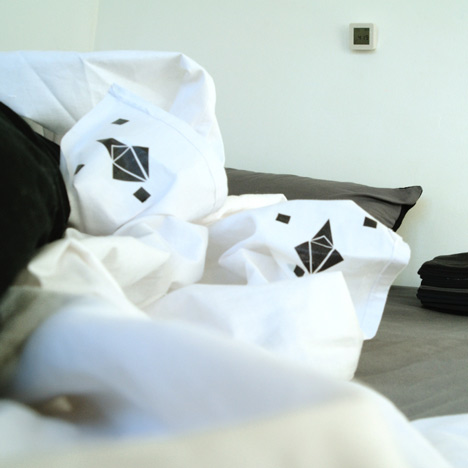
With Robots by Diego Trujillo Pisanty
How might our homes change if they had to accommodate robots too?
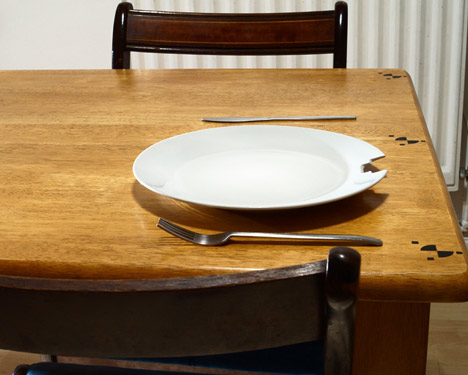
London designer Diego Trujillo Pisanty's With Robots project explores a near future where existing homes are adapted for domestic robots, rather than built around them.
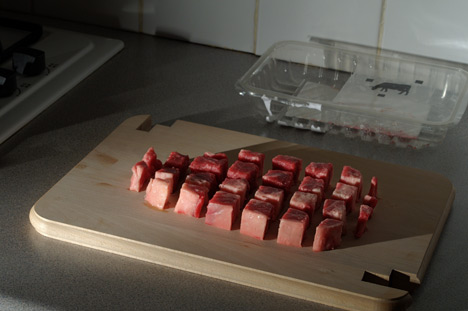
His conceptual images show objects with cut-outs or unusual handles so a robot can hold and manipulate them to help with household tasks.
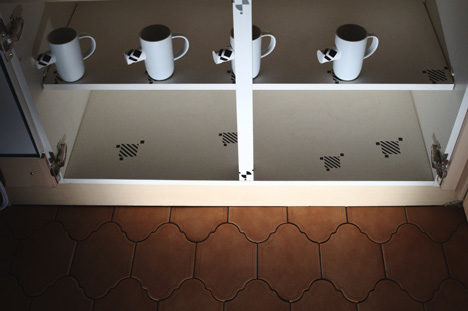
He predicts our houses will be littered with a series of symbols that could be understood by both humans and robots, marking the fold lines in bed linen for example or identifying the correct position for a cup inside the cupboard.
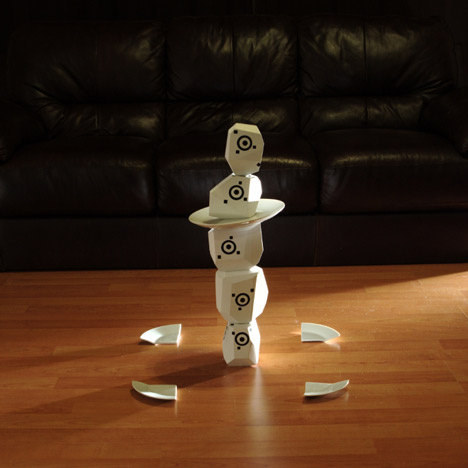
Diego Trujillo Pisanty developed the project while studying at the Royal College of Art in London.

Another recent Dezeen story about domestic robots featured a robotic vacuum cleaner that steals its owner's duvet in the morning and poos all over the floor.

You can see more robots on Dezeen here.
Here are some more details from Diego Trujillo Pisanty:
The field of robotics recently regained its momentum. As computers become smaller and more powerful it seems that we are close to having advanced autonomous robots everywhere, even in our homes.
With Robots takes a look at robots and homes and how they might interact. One common argument for humanoid robots is that as our environments are based around the scale and form of humans it is logical that robots operating in this space should be based on the same form. This project approaches the problem from a different perspective, looking at how our homes and objects might change in order to accommodate the needs of robots.
The scenario is not set in a specific time, however the images suggest a near future in which our homes look very much the same as they do now. They have been altered to fit robots rather than built for that purpose. The near future view allows us to suppose that the robots operating at home are one of the first generations and are not able to perform extremely advanced computations.
The project concentrates on the objects robots will need, trying to raise questions on the desirability of these items and the sacrifices we are willing to make in order to have robots in our home. Another important aspect is the atmosphere this new living space has, it is very simple to say “I have a robot and these are its things” but the way we feel surrounded by these objects should also be considered.
Most visual robot languages rely on data matrices which are meaningless to humans. It would be unfair to have meaningless symbols in our house in order for our domestic robots to work. An alphabet that could be understood by both humans and robot software would allow the owners of a domestic robot to understand what the robot is doing and would enable them to re-program it.
Folding
Robot friendly bed sheets were designed in order to aid them with a computationally demanding task. Based on previously research, a robot would take a long time to fold bed sheets, however if the folding points were marked by a tag the robot would be able to do it much faster. For the humans it means having a foreign symbol printed onto their bed sheet. In the background we see a small clock reading 4:19 which suggests the robot has been folding laundry for a very long time, even with the help of the tags.
Handling
Concentrating a bit more on how robots manipulate objects, a cup with a robot friendly handle was made. This object reveals a lot about the relationship between humans and robots, it creates a tension between the robotic and the human handle. The handle could become a design feature or it could be badly received, considered ugly and uncomfortable. The cupboard in which these cups rest have also been altered in order to accommodate the robot. Not only are there tags marking the position of objects but the doors have also been removed as they were not fit for A.I.
Serving
Setting the table is another task robots might be doing, having everything ready for when the owner comes home. The plate does not require a “plate tag” printed on it, the tag has been replaced by a notch on the edge indicating that this object is a plate. The notch also doubles as a holding point, it makes us wonder on the shape of the tool the robot uses to manipulate this object. The edges of the table are marked telling the machine where the limits are. In the scene presented the robot has made a mistake and placed all the cutlery rotated by 90o.
Learning
Every living space is different, not only in the architectural layout but also in the tasks that the tenants require robots to do. For this reason robots ship only partially programmed so that through a learning algorithm they might adapt to the home they operate in. To accelerate the learning process special learning tools have been designed to help the robot integrate to a 3D environment. The picture on this page shows a living room after a robot self-training session. We can see it has now mastered the physics of equilibrium. It is also evident that it has mistaken one of the house's dinner plates which it has broken with robotic precision to complete it's piece. This scene intends to make us think of what the tenants would think when encountering such a display. It also tries to show what it would feel like to have objects that are useful only to robots in our house.
Cooking
Cooking robots have been a promise for more then 60 years, ranging from Falks robotic toaster to the Jetsons' Rosie maid-bot.
How desirable is robot precision in the kitchen? The situation presented shows how meat has been precisely cut into cubes without leaving any cut marks on the chopping board. The board its self has notches to facilitate robot interaction. In the background the meat package can be seen, it too has been labelled to suggest that the robots oparate beyond a single house.